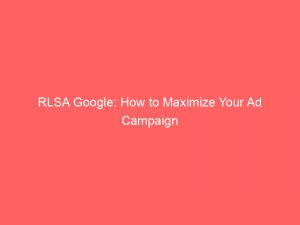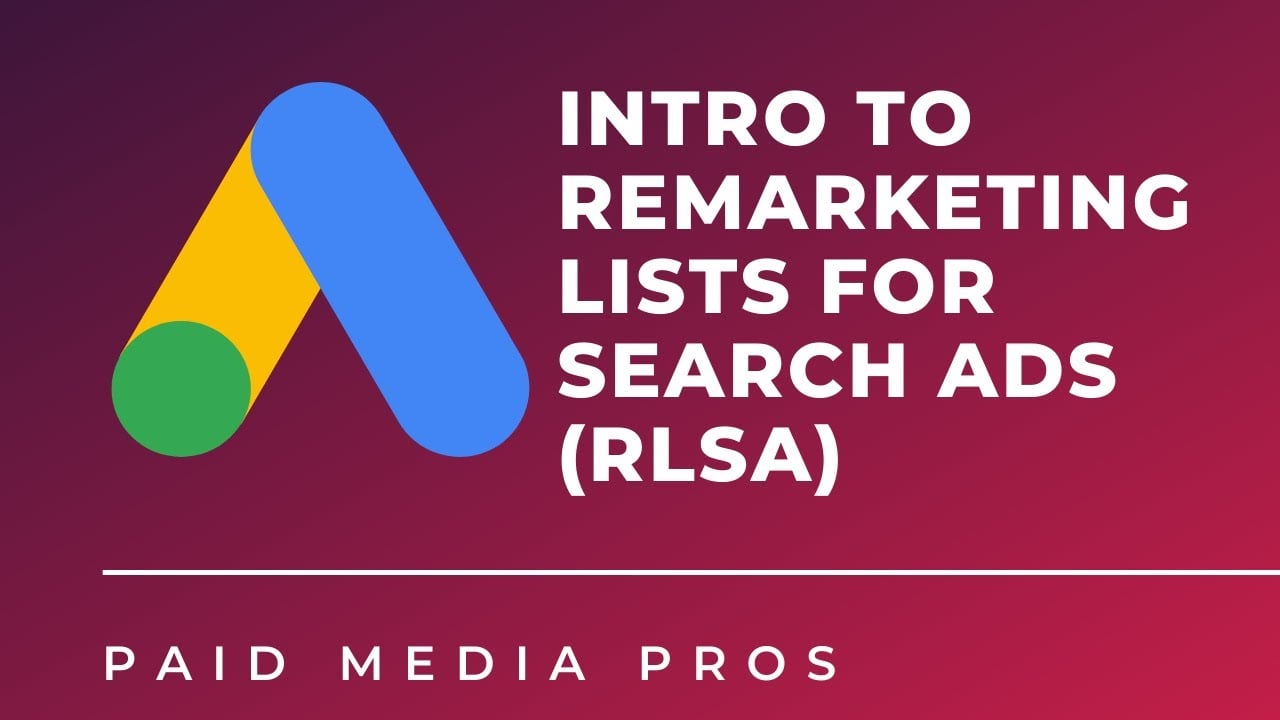In today’s digital age, successfully targeting the right audience is crucial for any business to thrive. Enter Remarketing Lists for Search Ads (RLSA) by Google.
With the power of analytics tags, RLSA allows marketers to create highly targeted campaigns, tracking the journey of users who have visited their website. By strategically bidding higher for users closer to conversion and matching messaging to their specific actions, businesses can maximize their chances of success.
Moreover, RLSA opens up a world of opportunities for upselling to converted users, bidding on broader search terms, and utilizing customer journey maps to optimize campaigns. Get ready to supercharge your digital strategy and unlock unprecedented leads and revenue.
Table of Contents
- rlsa google
- Enable Data Collection For Remarketing Features In Property Settings
- Associate Remarketing Lists With Search Ad Groups
- RLSA Works Similarly To Standard RLSA
- Maximum Lifespan Of A Remarketing List For Google Search Ads Is 540 Days
- Remarketing List Must Have At Least 1,000 Cookies To Be Used
- RLSA Helps Target Ads To Users Who Have Visited The Website
- Use Website Codes To Track User Journey And Bid Higher For Users Closer To Conversion
- Match Messaging In RLSA Ads To User Actions
rlsa google
RLSA, or Remarketing Lists for Search Ads, is a feature provided by Google that allows advertisers to target their ads to users who have previously visited their website. By using the Analytics tag, remarketing audiences can be created, enabling data collection for remarketing features in property settings.
These audiences can then be associated with search ad groups, allowing advertisers to bid higher for users who are closer to conversion. RLSA works similarly to standard RLSA, but the maximum lifespan of a remarketing list for Google search ads is 540 days.
To use RLSA, a remarketing list must have at least 1,000 cookies. It is also important to match messaging in RLSA ads to user actions and use customer journey maps to identify critical points of conversion.
By implementing customer journey maps, it is possible to improve RLSA campaigns and generate more leads and revenue. In addition, RLSA can be used to upsell to converted users by showcasing related products or services and bid for broader search terms to reach a wider audience.
Overall, RLSA is a valuable tool for targeting and optimizing Google Ads campaigns.
Key Points:
- RLSA is a feature provided by Google that allows advertisers to target ads to users who have visited their website.
- Remarketing audiences can be created using the Analytics tag, enabling data collection for remarketing features.
- Advertisers can associate these audiences with search ad groups and bid higher for users closer to conversion.
- The maximum lifespan for a remarketing list for Google search ads is 540 days.
- RLSA requires a remarketing list to have at least 1,000 cookies and matching messaging is important.
- RLSA can be used to improve campaigns, generate more leads and revenue, upsell to converted users, and reach a wider audience.
Sources
https://support.google.com/analytics/answer/6212951?hl=en
https://blog.hubspot.com/marketing/rsla-remarketing-lists-for-search-ads
https://support.google.com/adspolicy/answer/6258407?hl=en
https://support.google.com/analytics/answer/9759219?hl=en
Check this out:
💡 Pro Tips:
1. Segment your remarketing audiences based on different stages of the customer journey. By creating separate lists for users who have just visited your website, those who have viewed specific product pages, and those who have added items to their cart, you can tailor your ads and bidding strategies to match their level of interest and intent.
2. Experiment with different strategies for your RLSA campaigns. For example, you can try adjusting bids based on the time elapsed since a user’s last visit to your site, or bid higher for users who have previously made a purchase from your website.
3. Take advantage of dynamic remarketing to showcase personalized product recommendations to users who have shown interest in similar items. By dynamically generating ads with relevant products, you can significantly improve their effectiveness and drive additional conversions.
4. Use exclusion lists to prevent your RLSA ads from being shown to users who have already converted or taken the desired action on your website. This can help you optimize your ad spend by focusing on attracting new potential customers instead.
5. Consider running RLSA campaigns in combination with other targeting options, such as demographic or geographic targeting. By layering different targeting criteria, you can further refine your audience and reach the most relevant users with your ads.
Enable Data Collection For Remarketing Features In Property Settings
One of the key steps in maximizing the effectiveness of your RLSA (Remarketing Lists for Search Ads) campaign on Google is to enable data collection for remarketing features in your property settings. This allows you to gather valuable data on user behavior and create remarketing audiences based on their interactions with your website.
By enabling this feature, you open up the opportunity to retarget users who have previously visited your website, increasing the chances of conversion and driving more targeted traffic to your website through Google Ads display and search ads campaigns.
Associate Remarketing Lists With Search Ad Groups
Once you have enabled data collection for remarketing features, it is important to associate your remarketing lists with the relevant search ad groups. This helps in ensuring that your ads are shown to the right audience, increasing the overall efficiency and relevance of your campaign.
By associating remarketing lists with specific search ad groups, you can tailor your ads to users who have already shown interest in your website, making your ad messaging more targeted and personalized.
This increases the chances of driving conversions and maximizing the return on your ad spend.
RLSA Works Similarly To Standard RLSA
RLSA works similarly to standard RLSA, with the key difference being that RLSA specifically targets users who have visited your website. Standard RLSA, on the other hand, targets users based on their previous interactions with your ads.
By using RLSA, you can create remarketing lists based on website visitors and deliver tailored ads to these users when they perform relevant searches on Google.
This allows you to stay top-of-mind with potential customers and increase the chances of conversion.
Maximum Lifespan Of A Remarketing List For Google Search Ads Is 540 Days
Google has set a maximum lifespan of 540 days for remarketing lists used in Google search ads. This means that users who have visited your website within the past 540 days can be targeted with your ads.
It is important to regularly update and refresh your remarketing lists to ensure that you are targeting active and relevant users.
Outdated lists may result in wasted ad spend and ineffective targeting.
Remarketing List Must Have At Least 1,000 Cookies To Be Used
In order to use a remarketing list for Google search ads, the list must have at least 1,000 cookies. Cookies are small files stored on users’ devices that help track their interactions with your website.
Having a minimum of 1,000 cookies ensures that your remarketing list is large enough to provide meaningful data and allows for effective targeting of ads to a sizeable audience.
It is important to continuously build and grow your remarketing lists to reach more potential customers.
RLSA Helps Target Ads To Users Who Have Visited The Website
RLSA is a powerful tool that allows you to target your ads specifically to users who have previously visited your website. This targeting strategy increases the likelihood of conversion as you are reaching out to users who have already shown interest in your products or services.
By segmenting your website visitors into remarketing lists, you can create customized ad campaigns that speak directly to their interests and needs.
This relevancy not only increases the chances of conversion but also enhances the overall user experience.
Use Website Codes To Track User Journey And Bid Higher For Users Closer To Conversion
Tracking the user journey on your website is crucial for maximizing the effectiveness of your RLSA campaign. By implementing website codes, such as Google Analytics tags, you can gain insights into user behavior and determine where they are in the conversion funnel.
By tracking the user journey, you can identify users who are closer to conversion and adjust your bidding strategy accordingly.
Bidding higher for users who are more likely to convert can help improve the ROI of your ad campaigns and drive more meaningful results.
Match Messaging In RLSA Ads To User Actions
In order to maximize the impact of your RLSA ads, it is important to match your messaging to the user actions on your website. Understanding the specific actions users have taken can help you tailor your ad creative and messaging to their needs and interests.
For example, if a user added a product to their cart but did not complete the purchase, you can create an RLSA ad that offers a special discount or incentive to encourage them to return and complete the purchase.
By aligning your messaging with user actions, you can significantly improve the effectiveness of your RLSA campaigns.
Overall, implementing RLSA in your Google Ads campaigns can be a highly effective strategy for reaching and engaging potential customers. By enabling data collection for remarketing features, associating remarketing lists with search ad groups, and implementing customer journey tracking, you can create targeted and personalized ad campaigns that maximize your ad campaign’s success.
Remember to continually analyze and optimize your RLSA campaigns using customer journey maps to identify critical conversion points and improve ad performance. With a well-executed RLSA strategy, you can boost leads, drive revenue, and maximize the return on your ad spend.












